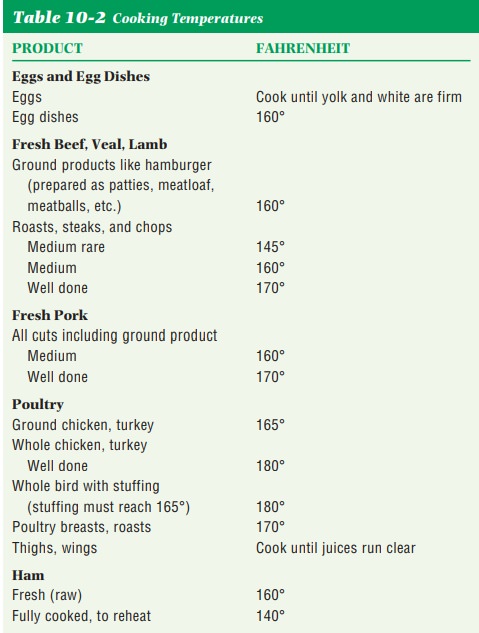Chapter: Nutrition and Diet Therapy: Food-Related Illnesses and Allergies
Prevention of Foodborne Illnesses
PREVENTION OF FOODBORNE
ILLNESSES
Strict federal, state,
and local laws regulate the commercial production of food in the United States,
and dairies, canneries, bakeries, and meatpacking plants are all subject to
government inspection. Nevertheless, errors and accidents can and do occur, and
illness can result. Most foodborne
illnesses occur because of the ignorance orcarelessness of people who handle
food. People can introduce pathogens to food, pre-vent them from reaching
it, or kill them with appropriate cooking temperatures.
Cleanliness is
especially important in preventing foodborne illness. When kitchen equipment
such as a cutting board, meat grinder, or countertop is used for preparing
pathogen-infected foods and not cleaned properly after-ward, noninfected food
that is subsequently prepared with this equipment can become infected by the
same pathogen(s). This is called cross-contamination. Dishes used to hold
uncooked meat, poultry, fish, or eggs must always be washed before cooked foods
are placed on them.
When food workers fail
to wash their hands after blowing their noses or using the toilet, they can
“share” their germs very easily. Mucus and feces are favorite breeding areas of
pathogens.
Food workers who have
even small cuts on their hands must wear gloves because a wound could carry a
pathogen. Foods must be covered and stored properly to keep dust, insects, and
animals from reaching and possibly con-taminating them. Water from unknown
sources should not be used for cooking because it, too, can carry pathogens.
Temperatures during preparation and storage of food must be carefully observed. When infected foods are undercooked, the pathogen is not de-stroyed and can be passed to consumers (Table 10-2). Foods allowed to stand at temperatures between 40° and 140°F provide an ideal breeding place for pathogens (Figure 10-1).

Leftover food should always be refrigerated as soon as the meal is finished and covered when it is cold. It should not be allowed to cool to room temperature before it is refrigerated. Frozen food should be either cooked from the frozen state or thawed in the refrigerator. (When cooked from the frozen state, cooking time will generally increase by at least 50%.) Frozen food should not be thawed at room temperature. Food must always be protected from dust, insects, and animals.

Carriers are people (or
animals) capable of transmitting infectious (disease-causing) organisms. Often
the carrier suffers no effects from the organism and therefore is unaware of
the danger she or he represents. Food workers should be tested regularly to
confirm that they are not carriers of communicable diseases.
Selection of food
should be made with great care. Packages and jars should be properly sealed.
Cans should not bulge. Foods that look or smell at all unusual and foods
showing signs of mold should be left in the store. Only pasteurized milk and
dairy products should be used (Table 10-3).

Related Topics